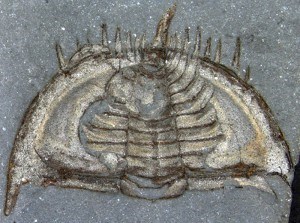
What’s so interesting about the fossilized remains of a sea creature the size of a thumbnail, that died hundreds of millions of years ago?
According to Dr. Javier Ortega-Hernández, a whole lot.
The research fellow at the University of Cambridge discovered the trilobite fossil after a 2010 research project in Jasper.
“I was definitely surprised to find these fossils,” he said in an interview last week.
The trilobite is an early species—Mummaspis muralensis, which belonged to a group called Olenellids—and it has changed scientists’ understanding of the animal’s defense mechanisms.
Trilobites were some of the first complex animals. They were marine arthropods, with segmented bodies and many tiny legs, and lived more than 500 million years ago, during the Cambrian period. They survived for more than 270 million years, partly due to their ability to adapt to increasingly dangerous predators.
One of the most important of these adaptations was the animal’s ability to roll itself into a ball, protecting its vital areas with its tough outer carapace.
Until Ortega-Hernández discovered the fossil, scientists believed that, since these trilobites lacked many of the adaptations of their younger relatives, early forms of trilobites couldn’t protect themselves in such a way.
Ortega-Hernández said his Mummaspis muralensis was a “smoking gun,” because it died while rolled up, proving early trilobites could do just that.
“Enrollment represents one of the most ancient defensive strategies known for any kind of animal,” Ortega-Hernández explained, and his discovery means that the Mummaspis muralensis is even more ancient than anyone realized: over 510 million years old.
“Getting these new insights on the origin of this important strategy is very significant to reconstruct the early evolution of the group,” Ortega-Hernández explained, adding that it will help scientists “understand the ecology of some of the first complex ecosystems that contained animal life.”
He said that, compared to its younger relatives, Mummaspis muralensis really wasn’t very good at rolling up. Unlike those younger relatives, it left vunerable areas unprotected when enrolled. He explained that it also didn’t have its ancestors’ complex locking mechanisms that allowed them to stay enrolled for long periods of time.
This weaker enrollment was likely why no one discovered any rolled up Olenellids before Ortega-Hernández. Since the creatures couldn’t stay enrolled, when they died their muscles would relax and they would unroll.
Ortega-Hernández’s specimen was preserved just after it died, so its fossilized remains were still rolled up.
“In this case, the tail is flexed under the head in order to cover the vulnerable underside, which is a typical characteristic of enrollment also observed in younger trilobites,” he said.
“The fossil also allows [us] to appreciate that the long spines near the tail effectively protect most of the head from below, which is the reason why some of the tips of these spines are found in front of the animal. Normally these would be facing towards the back.”
While the fossils were discovered in Jasper, Ortega-Hernández remained tight-lipped on exactly where.
He said Parks Canada is working hard to protect the important paleontological sites that sit within the park. Part of this means keeping their locations as little-known as possible to prevent any unwanted tampering.
Trevor Nichols
[email protected]
